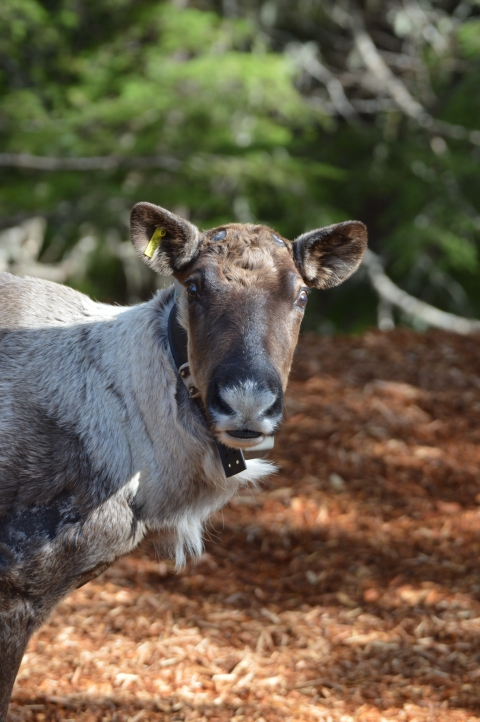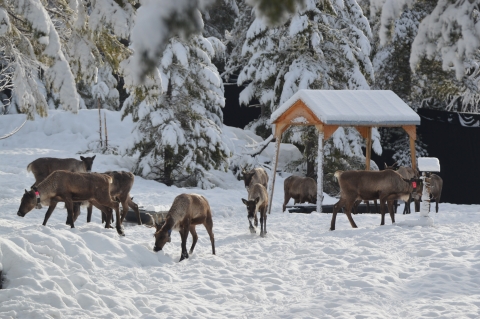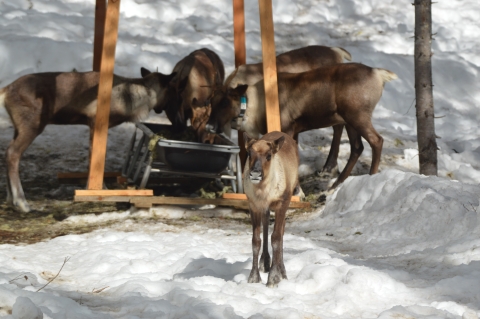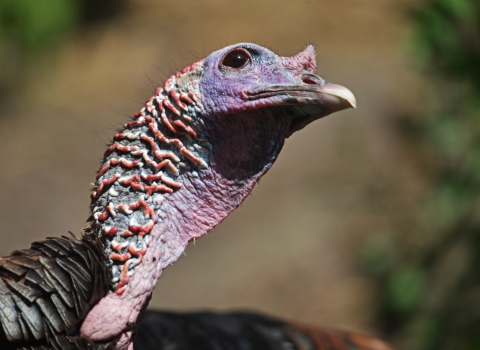By Jan Peterson, for the Pacific Region, U.S. Fish and Wildlife Service
This year is the 50th anniversary of the Endangered Species Act, a law that has been a powerful catalyst for conservation of America’s most treasured fish, wildlife, plants and their habitats. In the Pacific Region, our Tribes, state and federal agencies, and partners have joined with our dedicated staff to be the driving force behind the successes we share and the strength ensuring we can address the challenges ahead. Celebrate this milestone with us in this collection of stories as we reflect on past successes, assess current challenges, and envision an equally bright future for the next 50 years and beyond.
For 2 million years, caribou have roamed the Circumpolar North, which stretches to just south of the Canadian border in the Selkirk Mountains, encompassing portions of Washington, Idaho and Montana.
There are a variety of subspecies of caribou, each with its own habitat preference. Some of them, like the barren ground caribou, prefer barren arctic lands, while others, like woodland caribou prefer a woodland environment. The southern mountain caribou discrete subset of the woodland caribou, however, may have the most discriminating taste of them all. The optimal home for this discrete subset of woodland caribou is the temperate rainforest of the Selkirk Mountains where they can feast on lichen.
Unfortunately, these lichen-loving caribou are facing challenges. Although many populations of caribou are in trouble for a variety of reasons ranging from vulnerability to predators to human-driven changes to the landscape, none are so threatened as those in the southern and central Selkirks.
In recent decades, their numbers have been in a free fall. In 1983, numbers in the South Selkirk herd declined to fewer than 30 on the U.S. side of the border. Despite efforts to expandthe herd, its size dwindled to just three females by 2018.
By 2019, one lonely female remained in the continental United States. One of her herd mates had been predated and the other went missing. The lone female was transported to the Revelstoke Maternity Pen that year, and the Southern Mountain Caribou Distinct Population Segment was designated endangered by the Endangered Species Act. A distinct population segment is a vertebrate population that is discrete from other populations of the species. From a scientific standpoint, it was essentially game over for caribou in the continental United States.
The situation wasn’t much better in Canada. The Central Selkirk herd had around 220 animals in 1986, says Brittany Morlin, conservation partnerships wildlife biologist for the U.S. Fish and Wildlife Service’s Idaho Fish and Wildlife Office.
By 2021, only 28 caribou remained.
Endangered species recovery is complex and difficult work, often requiring substantial time and resources. Species today face ongoing threats including habitat loss, as well as new conservation challenges such as climate change climate change
Climate change includes both global warming driven by human-induced emissions of greenhouse gases and the resulting large-scale shifts in weather patterns. Though there have been previous periods of climatic change, since the mid-20th century humans have had an unprecedented impact on Earth's climate system and caused change on a global scale.
Learn more about climate change .
It was clear immediate action was needed. The Arrow Lakes Caribou Society formed and created the Central Selkirk Caribou Maternity Pen project, near Nakusp, British Columbia.
It was the last, best hope for protecting the herd in the Central Selkirks and, perhaps, for ever seeing a herd of caribou in the contiguous United States again.
Community mobilized to support recovery effort
Many people in the Nakusp area were deeply concerned about the caribou’s decline in their area of the central Selkirks. Supporters at all levels came together for community meetings and decided in 2019 to form the nonprofit Arrow Lakes Caribou Society.
The heart of its mission was to develop and implement caribou recovery efforts. The group looked northward to other caribou maternity pens in Klinse-Za and Revelstoke for guidance.
The community and Canadian government had tried many other methods of recovery. The government protected more than 740,000 acres of habitat from industry. The Caribou Society and snowmobile club collaborated on an adaptive sledding map to avoid caribou. Local heliskiing companies tracked caribou collars to stay out of the animals’ way. Predator populations were even controlled.
But the number of caribou continued to fall.
“We were on our last chance,” says Erin McLeod, Arrow Lakes Caribou Society project manager. A caribou maternity pen was their best and possibly last shot at preventing extirpation because it provides mothers and calves protection from predators, along with needed nutrition, for the critical first six weeks of the calves’ life.
Bart George, wildlife program manager for the Kalispel Tribe’s Natural Resources Department, was involved in those discussions.
“The loss of the South Selkirk herd was just heartbreaking for the Kalispel people. We had counted on them being in the Selkirk mountains for the last 10,000 years. To lose that group of animals was to lose a piece of the landscape,” says George, from Usk, Washington.
The Kalispels’ involvement proved instrumental in creating the caribou maternity pen. In addition to providing matching funds for the Arrow Lakes Caribou Society’s Gofundme campaign to get the project off the ground, the Tribe worked internationally to help find funding for the project.
“It’s an interesting thing because we’re working internationally,” George says. “The Tribe is more nimble than federal and state agencies to move money and have staff go to Canada. So, we’ve been able to leverage Tribal dollars and leverage that as match money. We can transfer money into Canada and make it go a bit further with matches.”
The Kalispel Tribe also turned to the U.S. Fish and Wildlife Service for support. The Service provided the Tribe funding to rent the helicopters to capture and transport pregnant caribou to the safety of the maternity pen. This year, the Service’s funding provided for the use of three helicopters, Morlin says.
Aaron Reid, wildlife biologist with British Columbia’s Ministry of Water, Land and Resource Stewardship, offers high praise for getting the project off the ground.
“I honestly do believe without the (Arrow Lakes Caribou Society ), we would not have started maternity penning, partly because this herd has such low numbers,” Reid says.
The visionary, innovative, and determined actions taken by Service team members and partners daily provide the critical information for decision-making that contributes to the success of the Endangered Species Act.
Facility provides safe, healthy harbor for caribou cows and calves
George points out the maternity pen is no kennel.
“This is a facility. It’s over 10 acres now. There’s 16-foot-high geotextile fabric walls and an electric fence to keep bears and other things from fooling with it,” he says.
The site was selected several years ago for its access as well as its location high in the central Selkirks. It features fresh water running throughout the pen, which is essentially an open-sky woodland from which brush has been cleared. A viewing tower allows veterinarians, biologists and shepherds – those who tend the animals – the opportunity to observe the caribou during their stay.
In March, pregnant cows are transported to the pen to complete their gestation, give birth in May or June in a predator-free environment and get much-needed nutrition after a long winter. Morlin says the nutrition is a crucial element in cow and calf survival after they are released in July.
In 2022, the first year the maternity pen was open, six calves and their mothers were successfully released to the wild. One other cow experienced a stillbirth and later succumbed to sepsis, Morlin says.
This year, the project collected 14 caribou: 10 females and four yearlings. Eight of the 10 females were pregnant.
“Last year, we had six calves released and four survived, which is great because normally only one or two survive in the wild,” says the ALCS’ McLeod. “This year, we released seven calves and only one is female, which is a bit too bad, but the males will still contribute to the population.”
Reid says the high male-to-female ratio worries him as a biologist, but “the part that calms me is this is a long game. Over the years, the ratio will balance out because older cows tend to produce males more often.”
In addition to the safety the pen provides, the caribou are given access to the nutrition they need to thrive. Their diet consists primarily of arboreal lichen, which drips from trees high in the mountains. Throughout the year, volunteers gather and dry lichen to be fed to the caribou throughout the calving season.
Initially, the caribou are given only lichen but they eventually transition to a prepared food topped with the lichen they crave.
Morlin says scientists aren’t sure what role the additional nutrition plays in female survival, but it appears to be significant. “That leads to some of the research we’re funding through the University of Idaho,” she says. “They’re not dying in the winter. Is there some other potential effect that may be associated with warm temps that is affecting nutrition? There are a lot of questions.”
In July, all of the cows and seven of the eight calves were successfully released back into the wild. Throughout the year, they will be monitored by scientists via transmitters on the animals’ collars or tags to see how they’re doing. The eighth calf failed to thrive and is now in the care of a wildlife rehabilitation center.
So far, George says the others are all doing really well.
McLeod says plans for next year are already well under way. She hopes to hire more veterinarians and use more helicopters.
George says they’ve already managed to scrounge up more funding for the pen and are seeing more and more buy-in from additional partners.
“We’re really excited they had so much success turning these animals loose,” he says. “It gives us ideas for what we need to do … As soon as this population is off life support, when the time comes, we’re definitely going to be asking for support (for a pen in the southern Selkirks). As it gains steam and creates some opportunities for success, I think the argument gets way easier to make to get animals back in the south Selkirks.
“It’s about more than caribou. It’s about having an ecosystem that is complete and whole.”






